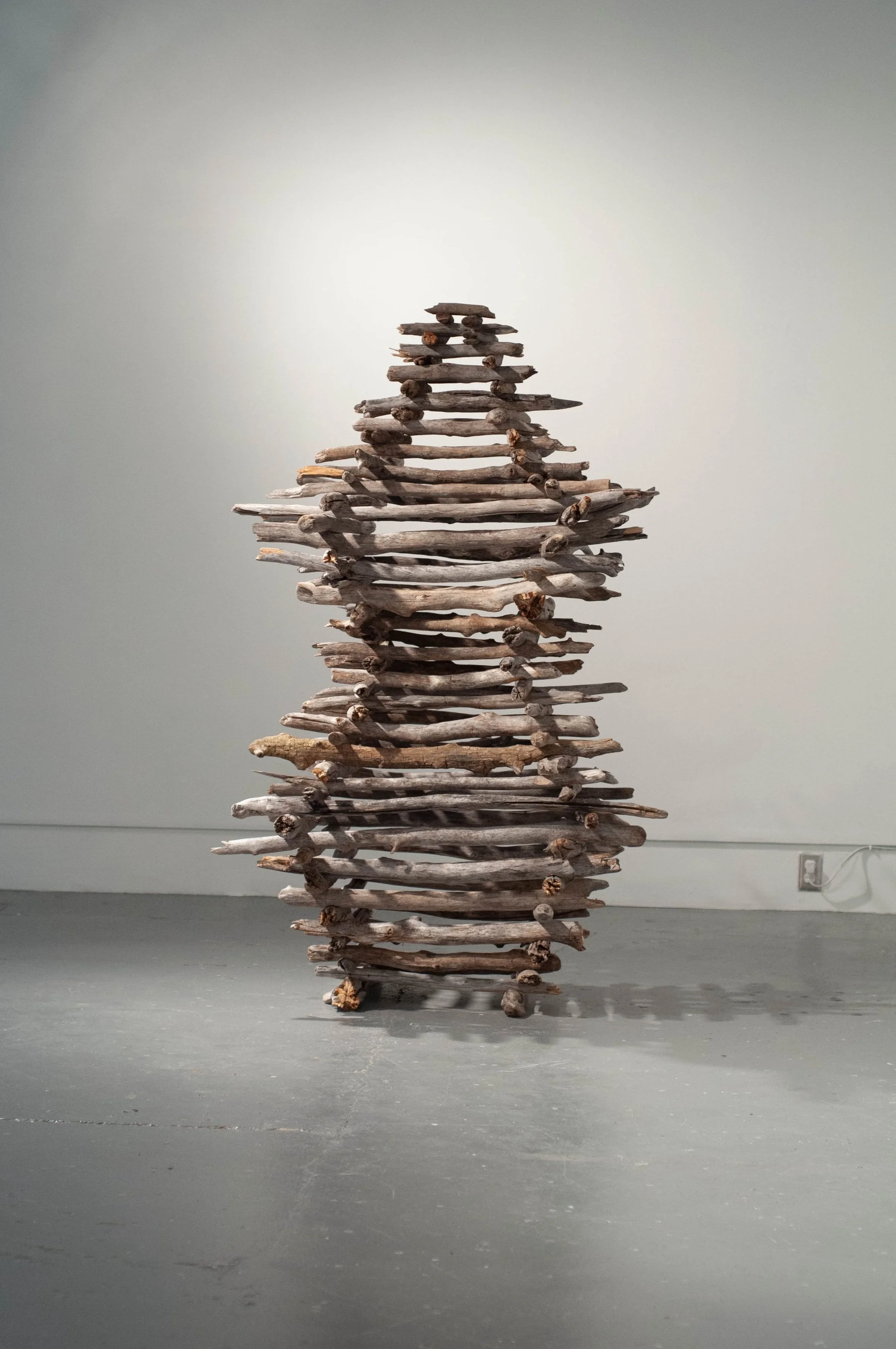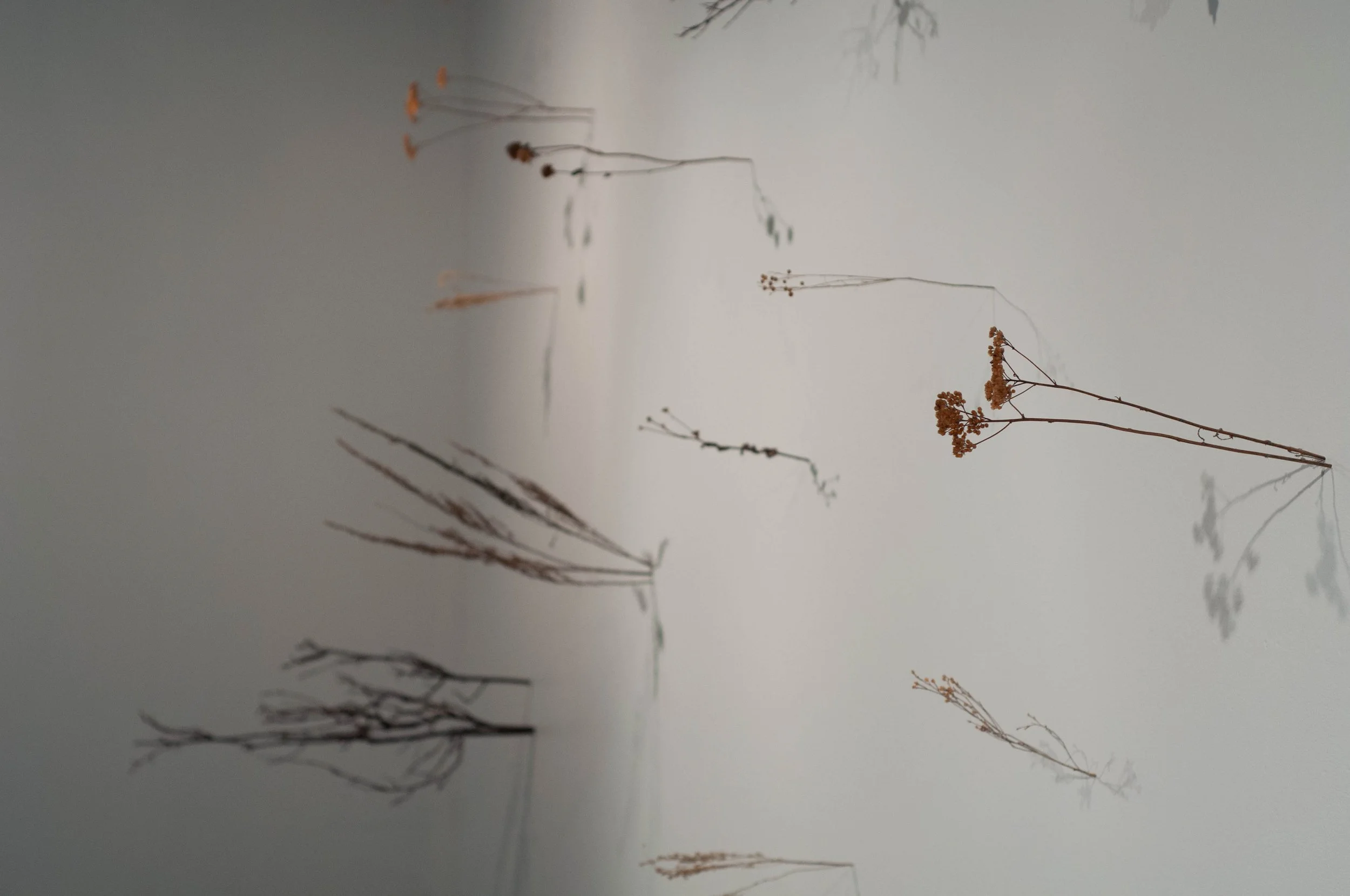Troy Nickle’s Process, Place and Perception, was a site-specific installation using natural materials. Natural elements from Kelowna’s landscape became part of the gallery architecture, playing with expectations of environment and place.
As though it was a bird’s eye view of the natural world, a selection of dried plants emerged horizontally from the wall. Driftwood, both suspended from the ceiling and dynamically gathering on the walls, created a sense of movement reflective of floating down a river. Central to the exhibition was a sculptural homage to Constantin Brancusi’s Endless Column- with driftwood stacked columns and columns high. Each work within the exhibition aimed to address the relationship between culture and nature.
Troy Nickle is an environmental artist currently living in Lethbridge, Alberta. His practice encompasses a variety of ideas and processes that stem from working in relation to the landscape and in tandem with nature. His site-specific artworks incorporate natural materials like wood, moss, mud, stone and vegetation to form assemblages that enhance one's experience of place. Previously enrolled in the BFA Program at the University of Lethbridge, Troy has also studied at the Alberta College of Art and Design in Calgary, and is a member of the Field Notes Collective in Lethbridge, AB.
For more information about Nickle’s work, visit his website.
Process, Place, Perception // Nicole Ensing
Too often we define nature as a separate entity from humans, ignoring that we are a part of the natural world. In Process, Place, Perception, Troy Nickle’s thoughtful installations bring a fresh nuance to our understanding of natural processes and what we interpret as art. Nickle challenges our connection with nature and culture, bridging the gaps in our relationships with the natural world.
Nickle’s body of work has an understanding of the ecosystem from which it was formed; he acknowledges environmental impact and future implications through his choice of materials. The many materials used in his pieces are not chosen on a whim, but are part of his artistic process. Nickle encounters the materials, like the plant species goldenrod, yarrow, or wild rose (some of the many species used in his installation) on walks and hikes while exploring Lethbridge or other parts of southern Alberta. He makes his selection, but waits until the individual plant has set its seed and dried and only then does he take a portion for his work.
Some of these plants are found in After the First Snow Fall, in which Nickle has situated twenty-six pieces (12 distinctive species) of dried plants such that they extrude from the wall as if reaching out to the viewer. Numerous shadows feather out from the lifeless plants in a spirited fashion, mimicking the life that once existed. This piece disrupts the usual interactions we have with plants, often looked down upon by us, but now facing us at eye level, inviting us in. By challenging our normal perception of the natural world, Nickle has highlighted our general disregard for those small plants and the value they hold.
Similarly, Goldenrod Doodle, reaches out from the wall, although the twisted goldenrod has taken on a new form. Due to a fly larva, an engorged gull is now a part of each plant, the plants are twisted and gnarly as if ignoring the shape and order imposed upon it on the wall. Nickle’s arrangement of the materials provides the viewer with a new way of seeing. By elevating and creating structure with the natural materials within the gallery, it challenges the viewer to change their perception of what art can be.
His piece, Endless, stands in the corner of the gallery as if a somber reminder of the past and of things to come. Endless pays homage to The Endless Column by Constantin Brâncuși, symbolizing "Infinite Sacrifice.” Reflecting Brâncuși in form, Endless is a tower of rhomboidal shapes, constructed with drift wood pieces. Nickle’s sculpture brings a material like wood to the forefront, a material that can break down, illuminating the ceaseless ephemeral processes of nature. The structure itself is reflective, possibly symbolizing a stupa (Buddhist shrine), or simply bestowing the gallery with a drift wood cairn. It is this uncertainty that context can impose, thus the viewer is encouraged to take from their own experience, and to think carefully about what the shape, structure, and materials mean to them.
In Process, Place, Perception, Troy Nickle’s installations echo a spiritual sense of understanding; each piece is contemplative and meditative, and open to interpretation. Nickle has put our interactions with nature at the fore, questioning our understanding of life, and our role within it. Nickle provides us with opportunity to look upon nature in an altered context, re-envisioning our relationship to the natural world.





